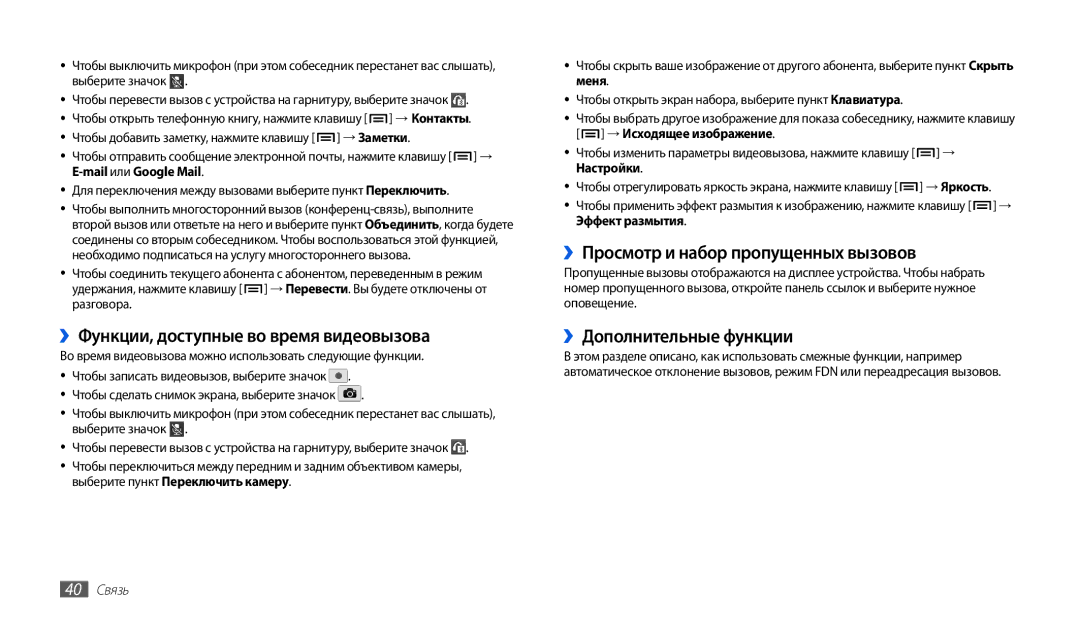Руководство пользователя
Сохраните это руководство для использования в будущем
Данном руководстве
Данном руководстве
Обозначения, используемые в данном руководстве
Авторские права
Товарные знаки
Блокировки
Видео В Формате Divx
Может воспроизводить видео DivX в формате до HD 1080p
Содержание
Содержание
Связь
Меры предосторожности
Сборка устройства
Комплект поставки
Зарядка аккумулятора
Внешний вид зарядного устройства зависит от региона
Вставка SIM- или USIM-карты
Вставьте SIM- или USIM-карту
Установка карты памяти дополнительно
10 Сборка устройства
››Извлечение карты памяти
››Форматирование карты памяти
Начало работы
Включение и выключение устройства
››Переключение устройства в автономный режим
››Переключение в профиль «Без звука»
››Внешний вид устройства
Общие сведения об устройстве
Начало работы
››Значки состояния
››Клавиши
14 Начало работы
Включен профиль «Без звука»
Включен режим вибрации
Включен профиль «Автономный»
Выполняется воспроизведение музыки
Сенсорный экран
››Поворот сенсорного экрана
››Блокировка и разблокировка сенсорного экрана
Выберите пункт Блокировка поворота
Общие сведения о главном экране
››Добавление элементов на главный экран
Работа с приложениями
››Перемещение элементов на главный экран
››Удаление элементов с главного экрана
››Добавление ярлыка для приложения
Индивидуальная настройка устройства
››Включение анимации для переключения между приложениями
››Регулировка яркости дисплея
››Блокировка экрана
Задать блокировку экрана → Рисунок
››Блокировка SIM- или USIM-карты
››Включение функции оповещения о смене SIM-карты
Задать блокировку экрана → Пароль
Настройка оповещения
Ввод текста
››Изменение режима ввода текста
››Ввод текста с помощью клавиатуры Swype
Уберите палец с последней буквы
››Ввод текста с помощью клавиатуры Samsung
Удаление введенных символов
››Копирование и вставка текста
24 Начало работы
Интернет
Интернет
››Просмотр веб-страниц
Номер Назначение Перемещение вперед или назад по страницам
››Просмотр нескольких страниц
››Голосовой поиск информации
26 Интернет
››Добавление закладок для веб-страниц
››Добавление канала RSS-новостей
Выберите значок → Закладки → Изменить → Удалить
Удалить → Удалить
Книги и пресса
Новости и погода
››Просмотр прогноза погоды
››Чтение статей
Pulse
Samsung Apps
››Чтение новостных каналов
››Управление источниками новостей
Магазин приложений
YouTube
››Загрузка и установка приложения
››Удаление приложения
Ежедневная информация
››Отправка видео
››Настройка параметров ежедневной информации
››Просмотр ежедневной информации
Карты
Локатор
››Поиск определенного местонахождения
››Получение маршрутов проезда к заданному пункту назначения
Адреса
Навигация
Поиск
Режиме меню выберите пункт Поиск
Связь
Google Mail
››Отправка сообщений по электронной почте
››Просмотр сообщений электронной почты
Электронная почта
››Настройка учетной записи электронной почты
Выберите пункт Изменить ярлыки
Выберите метку, а затем пункт OK
Google Talk
››Добавление друзей в список
Приглашение
36 Связь
Сообщения
››Начало разговора
››Отправка SMS-сообщений
››Отправка MMS-сообщений
Вызовы
››Просмотр SMS- и MMS-сообщений
››Прослушивание голосовых сообщений
38 Связь
››Выполнение вызова или ответ на вызов
››Функции, доступные во время голосового вызова
››Функции, доступные во время видеовызова
››Просмотр и набор пропущенных вызовов
››Дополнительные функции
40 Связь
Выберите пункт Черный список
Нажмите клавишу → Создать
Чтобы добавить другие номера, повторите шаги
Использовать в режиме FDN
››Просмотр журнала вызовов
Social Hub
42 Связь
Развлечения
Музыка
››Загрузка музыкальных файлов на устройство
››Воспроизведение музыки
Музыкальный портал
››Создание списка воспроизведения
→ Настройки
44 Развлечения
Камера
››Фотосъемка
››Съемка серии фотографий
››Съемка фотографий с помощью параметров для разных сюжетов
››Панорамная съемка
››Фотосъемка в режиме распознавания улыбки
››Фотосъемка в режиме автопортрета
››Настройка фотокамеры
Наведите объектив камеры на объект
››Видеосъемка
48 Развлечения
››Настройка параметров видеозаписи
→ Воспроизвести
Видео
Галерея
››Просмотр фотографий
50 Развлечения
››Воспроизведение видео
Выберите фотографию для просмотра без значка
Личные данные
Контакты
››Создание контакта
››Поиск контакта
››Создание группы контактов
››Создание визитки
››Копирование или перемещение контактов
Календарь
››Импорт и экспорт контактов
››Изменение режима отображения календаря
››Добавление события
Заметки
››Просмотр событий
››Выключение сигнала о событии
››Создание заметки
Возможности передачи данных
Подключение к ПК
››Подключение с помощью программы Samsung Kies
››Синхронизация с проигрывателем Windows Media
Wi-Fi
Выберите пункт Wi-Fi, чтобы включить функцию Wlan
››Включение функции Wlan
Возможности передачи данных
››Поиск беспроводной сети и подключение к ней
Общий доступ к мобильной сети
››Добавление сети Wlan вручную
Bluetooth
››Доступ к мобильному сетевому подключению с помощью Wlan
››Доступ к мобильному сетевому подключению с помощью USB
Доступа
››Передача данных с помощью беспроводной связи Bluetooth
››Включение беспроводной связи Bluetooth
Подключение к ним
AllShare
››Настройка параметров Dlna для обмена медиафайлами
Мобильной сети
Включение функции определения вашего
Выберите пункт Телевизионная система
Финляндия, Швейцария, Швеция
››Установка VPN-соединений
VPN-соединения
Добавить VPN
››Подключение к частной сети
64 Возможности передачи данных
Электронные книги
Инструменты
ThinkFree Office
Мои файлы
››Создание нового документа
››Просмотр и редактирование документов на устройстве
››Управление документами в интерактивном режиме
››Поддерживаемые форматы файлов
››Открытие файла
››Создание папки
››Копирование или вырезание файлов
Фоторамка
Загрузки
Будильник
Калькулятор
››Установка нового сигнала
››Выключение сигнала будильника
››Отключение сигнала будильника
Диспетчер задач
Мировое время
Голосовой поиск
Рукописная заметка
→ Сохранить
Работа с меню настроек
Настройки
Сеть
››Мобильные сети
››Настройки USB
››Синхронизация
››Номера FDN
Звук
Дисплей
GPS и Безопасность
Обои
Настройка блокировки SIM-карты
Разработка
Приложения
76 Настройки
Учетные записи и синхронизация
Конфиденциальность
Карта памяти SD и память устройства
Язык и ввод
Голосовой ввод и вывод
››Swype
››Клавиатура Samsung
››Параметры распознавания голоса
Специальные возможности
Дата и Время
Об устройстве
››Преобразование текста в речь
Устранение неполадок
Код Возможное решение проблемы Пароль
Планшета
Блокировка SIM-карты
Зарядите аккумулятор
Устранение неполадок
Убедитесь, что телефон поддерживает тип данного файла
82 Устранение неполадок
Меры предосторожности
Меры предосторожности
Выключайте планшет, если запрещается его использование
Запрещается использовать планшетрядом с кардиостимулятором
Выключайте планшетв потенциально взрывоопасной среде
Выключайте планшетна борту самолета
Избегайте попадания влаги на планшет
Не кладите планшет на наклонные поверхности
Не храните планшет рядом с источниками магнитного поля
Высоким давлением
Не роняйте планшети избегайте силового воздействия на него
Не кусайте и не лижите планшетили аккумулятор
Не носите планшетв заднем кармане брюк или на поясе
При очистке планшета соблюдайте следующие инструкции
Аккуратно обращайтесь с SIM-картами и картами памяти
Доступ к службам экстренной помощи
Правильная утилизация изделия
88 Меры предосторожности
Отказ от ответственности
Алфавитный указатель
Ответ
Функции во время видеовызова
Настройка параметров видеозаписи 49 фотосъемка
Поиск сетей и подключение к ним 58 точка доступа WPS
Дата и время Дисплей
Алфавитный указатель
Bluetooth включение 60 передача данных
Внешний вид
Настройки Панель ссылок
92 Алфавитный указатель
Сертификат Соответствия
GT-P1000
Установка ПО Kies Синхронизация с ПК

